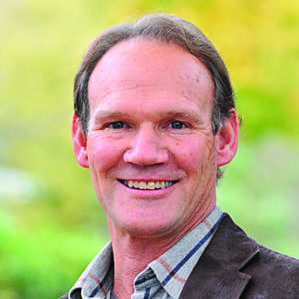Op/Ed
Faith Gong: Miracles

My daughter found the caterpillar during a hike in Wright Park on Labor Day 2020.
We hadn’t seen this type of caterpillar before, its bands of green interspersed with black and gold dots. Thankfully we were with friends who knew: “It’s a swallowtail caterpillar.”
Could we bring it home to hatch? my children wanted to know.
We could try.
We installed the caterpillar in our butterfly house, where it coexisted with our final monarch butterfly chrysalis of the season. We researched what swallowtail caterpillars eat (plants in the carrot family) and picked it plenty of Queen Anne’s Lace leaves from our yard. We didn’t have to wait long: After a couple of days, the caterpillar had enclosed itself into a chrysalis hanging from the top rim of the butterfly house. Unlike the lovely green-and-gold chrysalis of the monarch butterfly, the swallowtail chrysalis looked more like a dead, rolled-up leaf.
Having raised numerous monarch butterflies, we knew how to wait. We waited and waited. Our final monarch butterfly hatched and was released. Still, we waited for the swallowtail.
After a few weeks with no sign of life, I asked my daughter to research how long it should take a swallowtail butterfly to emerge. I suspected that something had gone wrong, perhaps because it was so late in the season. My daughter reported back: “It can take a few weeks to several months, Mommy! We should keep waiting.”
I was willing to give the butterfly a chance. But by December, with no change to the chrysalis and with Christmas decorations to hang, I was ready to give up and consign our butterfly house to the garage for the winter.
“No!” my daughters implored me. “It said ‘several months!’ Can we please keep it?”
Not wanting to be cruel, I agreed; we all needed something to hope in this winter. But I was concerned that my daughters’ hope would turn to disappointment. 2020 became 2021, snow piled up outside, and still that lifeless brown chrysalis hung in our butterfly house. Whenever I noticed it, I’d wonder when I could throw it out without eliciting screams of protest from my girls.
One day in early March, almost exactly six months from the day we found the swallowtail caterpillar in Wright Park, I did hear my girls screaming. They were screaming, “Mommy, come quick! Our butterfly!!”
A newly hatched black swallowtail butterfly was testing its wings inside our butterfly house.
I’m going to pause here to suggest that our lexicographers should consider revising the definition of the word “miracle.” A search of multiple dictionaries turned up versions of this working definition (from lexico.com): “Miracle (n): An extraordinary and welcome event that is not explicable by natural or scientific laws and is therefore attributed to divine agency.”
In my experience, that’s not quite right.
I can explain how this swallowtail hatched using natural and scientific laws: it overwintered in our butterfly house. At the same time, I can’t explain it at all: This tiny, fragile bit of beauty and life emerged after six months in a dry brown husk. Were you to draw diagrams and use all the proper scientific words, I’d still insist that this was, at some level, a miracle.
I feel the same way about the births of each of my children, about people who recover from life-threatening illnesses, and about the fact that I exist on this particular planet that is crammed with life and spinning through solar systems, galaxies, and universes so vast we will likely never comprehend them all.
Just because something can be explained doesn’t mean that it can be understood. Life itself, for all our scientific and medical knowledge, retains a spark of mystery, an element of inexpressible wonder.
We marveled, wonder-filled, at this very alive black swallowtail butterfly. My daughters determined that it was a female, and promptly named her “Lady Jewel.”
After the initial rejoicing, however, we realized that we were going to have to come up with a plan for Lady Jewel. Usually when we hatch a butterfly, we wait several hours for its wings to dry, and then we release it into nature. But it was early March in Vermont: Snow still blanketed the ground, and even when that snow melted it would be at least a month before consistently warm temperatures and budding flowers made the world hospitable for a butterfly.
Miracles almost always require responsibility from those whom they visit. We tend to think of miracles as a “happily ever after” end in themselves, but that’s seldom the case. The baby is born, and you have a lifetime of parenting ahead. You recover from the illness and have to learn how to live again. Your existence on this planet entails a tangle of responsibilities to all other living things. We were responsible for taking care of this butterfly.
An internet search yielded a recipe for making butterfly nectar with sugar and water. Along with this food, my daughters added some small potted houseplants to the butterfly house to make Lady Jewel more comfortable. Then we awaited the arrival of warm spring weather.
Sometimes I wondered whether we’d done the right thing. If we’d left her in caterpillar form in Wright Park in September, would she have survived the winter and emerged from her chrysalis at a more appropriate time? Did we mess with a natural process and, in doing so, doom this butterfly to a life of captivity?
A month later, Lady Jewel was still alive. She looked older and wiser to the ways of the world; her wings bore the marks of encounters with our cat and the sides of her butterfly house. As the lifespan of the average swallowtail butterfly is about two weeks, Lady Jewel was positively geriatric.
The week after Easter brought a series of warm and sunny days. The crocuses and daffodils bloomed. While it was still early for butterflies — too soon to rule out the possibility of frost — my daughters and I agreed that it was time to release Lady Jewel. She was likely nearing the end of her life anyway; why not allow her to stretch her aged wings in the unfiltered sunlight and sense the space of the endless blue sky above her? She’d feel as if she’d flown into a miracle.
The night before we planned to release her, I found Lady Jewel dead on the floor of the butterfly house. My daughters weren’t as heartbroken as I’d expected, perhaps because they’re getting used to losing animals, or perhaps because Lady Jewel had lived such a long life. They buried her in the front flower garden.
I can explain how this swallowtail died using natural and scientific laws. At the same time, I can’t explain it at all: She hatched after six months from the deadest-looking chrysalis I’d ever seen, she fluttered on painted wings through the drab Vermont mud season, and one day the fragile spark of life in her burned out. A living thing had been here, and now it was gone.
When I think about it like this, I see that death, for all our scientific and medical knowledge, retains a spark of mystery, an element of inexpressible wonder: Death, like life, is a miracle.
Faith Gong has worked as an elementary school teacher, a freelance photographer, and a nonprofit director. She lives in Middlebury with her husband, five children, assorted chickens and ducks, one feisty cat, and one anxiety-prone labradoodle. In her “free time,” she writes for her blog, The Pickle Patch.
More News
Op/Ed
Editorial: Gov. Scott’s one-sided story
Last year, Phil Scott took the lead on education reform and he spent his address on Wednes … (read more)
Op/Ed
Schools, housing, healthcare are Legislature’s top priorities
“I want to give folks an update on what might be on the legislative agenda, as well as sha … (read more)
Op/Ed
Ways of Seeing: Age doesn’t define us
“I’d had it with hearing about yet one more thing anyone over 40 can’t, shouldn’t, or won’ … (read more)










